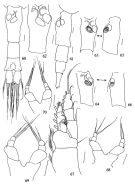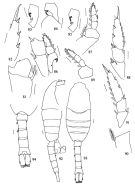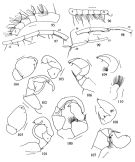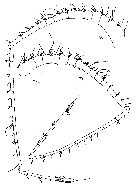|
|
 |
|
Calanoida ( Order ) |
|
|
|
Metridinidae ( Family ) |
|
|
|
Metridia ( Genus ) |
|
|
| |
Metridia pseudoasymmetrica Markhaseva, 2001 (F,M) | |
| | | | | | | Ref.: | | | Markhaseva, 2001 (p.46, figs.F,M); Park & Ferrari, 2009 (p.143, Table 3, Appendix 1, biogeography from Southern Ocean) |  issued from : E.L. Markhaseva in Zoosys. Rossica, 2001, 9 (1). [p.58, Figs. 60-70]. Female (from 69°06'S, 95°02'W): 60, urosome (dorsal view); 61, idem (left lateral view); 62-64, genital somite (ventral view); 65-66, idem (left lateral view); 67, first leg; 68-70, fifth leg (from different stations)
|
 issued from : E.L. Markhaseva in Zoosyst. Rossica, 2001, 9 (1). [p.61, Figs. 81-94]. Female: second leg (coxopod and basipod); 82, second leg (margin of Exp 3, laterally); 83-85, second leg (endopod.1, different positions); 86, second leg (exopod.2-3 and endopod.); 87, third leg (coxopod, basipod and endopod); 88, third leg (exopod); ; 89, fourth leg (basipod and endopod); 90, fourth leg (coxopod); 91, fourth leg (exopod). Male: 92, habitus (right lateral view); 93, idem (dorsal view); 94, distal part of prosome and urosome (dorsal view).
|
 issued from : E.L. Markhaseva in Zoosyst. Rossica, 2001, 9 (1). [p.62, Figs.95-110]. Male: 95, left A1 (segments 1-5); 96, idem (segments 6-11); 97, idem (segments 12-16); 98, idem (segments 16-18); 99, idem (segments 19-20); 100, fifth legs; 101-102, left leg (different positions); 103-105, left leg (exopod 2-3, different positions); 106-107, right leg (different positions); 108, right leg (exopod 2-3); 109, right leg (exopod 3, other view than 108); 110, right leg (basipod, lateral swelling)
|
 issued from : E.L. Markhaseva in Zoosyst. Rossica, 2001, 9 (1). [p.59, Figs.71-78]. Female: 71, A2; 72, A2 (exopodite, other position); 73, Md; 74, Mx1; 75, Mx1 (exopodite; 76, Mx2 (inner lobe 1-inner lobe 6); 77, Mx2 (inner lobes 5-6 and exopod); 78, Mxp.
|
 issued from : E.L. Markhaseva in Zoosyst. Rossica, 2001, 9 (1). [p.60, Figs.79-80]. Female: 79, right A1; 80, left A1.
| | | | | NZ: | 2 | | |
|
Distribution map of Metridia pseudoasymmetrica by geographical zones
|
| | | | | | | Loc: | | | Antarct. (Pacif.), Sub-Antarct. (Drake Passage) | | | | N: | 2 | | | | Lg.: | | | (823) F: 3,8-3,31; M: 3,5-2,87; {F: 3,31-3,80; M: 2,87-3,50} | | | | Rem.: | bathypelagic.
After Markhaseva (2001, p.46) the speciesis similar to M. asymmetrica Brodsky, 1950, but females differ in the shape and location of spermatheae (oval and overlapping in lateral view in M. pseudoasymmetrica ; round and not overlapping in lateral view in M. asymmetrica) ; distinct indentation in the posterior third of the genital somite in lateral view (indentation weakly pronounced in M. asymmetrica) ; and the subdivided hook-like spines at endopod segment 1 of P2, with markedly unequal horns (the horns are slightly unequal in length in M. asymmetrica). Males of these two species are very simolar, but M. pseudoasymmetrica differs in the presence of small setae supplied with setules in laft lateral distal part of P5 basipod and small distal lateral seta at exopod segment 1 of left P5, and absence of short spinules au urosomal somite 2 on the right and presence of short hairs at urosomal somite 4 on the left. | | | Last update : 17/01/2015 | |
|
|
 Any use of this site for a publication will be mentioned with the following reference : Any use of this site for a publication will be mentioned with the following reference :
Razouls C., Desreumaux N., Kouwenberg J. and de Bovée F., 2005-2025. - Biodiversity of Marine Planktonic Copepods (morphology, geographical distribution and biological data). Sorbonne University, CNRS. Available at http://copepodes.obs-banyuls.fr/en [Accessed December 31, 2025] © copyright 2005-2025 Sorbonne University, CNRS
|
|
 |
 |








